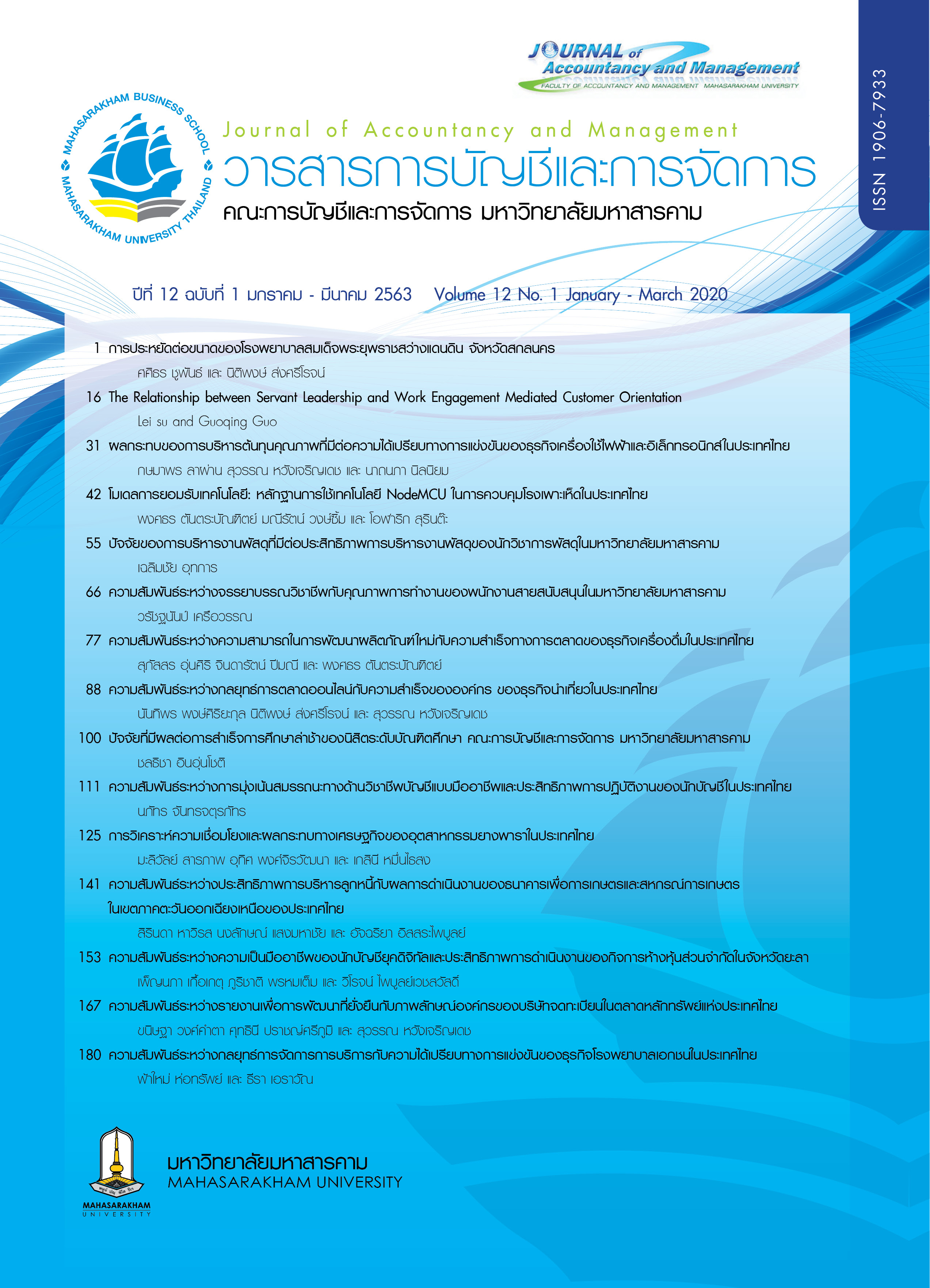การวิเคราะห์ความเชื่อมโยงและผลกระทบทางเศรษฐกิจของอุตสาหกรรมยางพาราในประเทศไทย
Main Article Content
บทคัดย่อ
การวิจัยครั้งนี้มีวัตถุประสงค์เพื่อวิเคราะห์ความเชื่อมโยงของอุตสาหกรรมยางพาราที่มีผลต่อสาขาเศรษฐกิจที่สำคัญ รวมถึงเพื่อวิเคราะห์ผลกระทบทางเศรษฐกิจของอุตสาหกรรมยางพาราที่มีตัวแปรทางด้านเศรษฐกิจที่สำคัญ โดยใช้การวิเคราะห์ตารางปัจจัยการผลิตและผลผลิต ตัวทวีคูณทางด้านเศรษฐกิจ และโครงข่ายความเป็นศูนย์กลางทางเศรษฐกิจ การศึกษาในครั้งนี้แบ่งกลุ่มสาขาการผลิตเป็น 180 สาขา ในปี พ.ศ. 2543 พ.ศ. 2548 และปี พ.ศ. 2553 โดยพิจารณาให้สาขาการทำสวนยางพารา สาขาการผลิตยางแผ่นรมควัน ยางเครปและยางแท่ง สาขาการผลิตยางนอกและยางใน และสาขาการผลิตผลิตภัณฑ์ยางอื่นๆ เป็นตัวแทนของอุตสาหกรรมยางพารา ผลการวิจัยพบว่า จากการวิเคราะห์ความเชื่อมโยงไปข้างหน้า พบว่า สาขาของอุตสาหกรรมยางพารากระจายผลผลิตไปยังสาขาการผลิตยางแผ่นรมควัน ยางเครปและยางแท่ง สาขาการซ่อมแซมยานพาหนะทุกชนิด และสาขาการผลิตยานยนต์ มากที่สุดตามลำดับ จากการวิเคราะห์ความเชื่อมโยงไปข้างหลัง พบว่า สาขาของอุตสาหกรรมยางพาราใช้ปัจจัยการผลิตจากสาขาการผลิตยางแผ่นรมควัน ยางเครปและยางแท่ง สาขาการทำสวนยางพารา และสาขาการค้าส่ง มากที่สุดตามลำดับ ในส่วนของค่าตัวทวีคูณการรั่วไหลของรายได้จากการนำเข้าและภาษีทางอ้อม พบว่า สาขาของอุตสาหกรรมยางพาราทำให้รายได้ของประเทศลดลงน้อยกว่าค่าเฉลี่ยของการรั่วไหลจากการนำเข้าและภาษีทางอ้อมของสาขาการผลิตอื่นๆ และจากการวิเคราะห์โครงข่ายความเป็นศูนย์กลางทางเศรษฐกิจ พบว่า ในปี พ.ศ. 2553 มีค่าความเป็นศูนย์กลางเพิ่มขึ้นจากปี พ.ศ. 2543 หมายความว่า มีการใช้ปัจจัยการผลิตและมีการกระจายผลผลิตระหว่างสาขาของอุตสาหกรรมยางพาราไปยังสาขาเศรษฐกิจอื่นๆ เพิ่มขึ้นทุกสาขาเศรษฐกิจ สาขาที่มากที่สุดภายในสาขาของอุตสาหกรรมยางพารา ได้แก่ สาขาการผลิตผลิตภัณฑ์ยางอื่นๆ ดังนั้น รัฐบาลควรให้การสนับสนุนและส่งเสริมพัฒนาอุตสาหกรรมยางพาราอย่างถูกต้อง จะช่วยให้เกิดการขยายตัวของผลผลิตและรายได้ของสาขาเศรษฐกิจอื่นๆ ที่เกี่ยวข้องตามไปด้วย
Downloads
Article Details
บทความที่ได้รับการตีพิมพ์เป็นลิขสิทธิ์ของวารสารการบัญชีและการจัดการ
ข้อความที่ปรากฏในบทความแต่ละเรื่องในวารสารวิชาการเล่มนี้เป็นความคิดเห็นส่วนตัวของผู้เขียนแต่ละท่านไม่เกี่ยวข้องกับมหาวิทยาลัยมหาสารคาม และคณาจารย์ท่านอื่นๆในมหาวิทยาลัยฯ แต่อย่างใด ความรับผิดชอบองค์ประกอบทั้งหมดของบทความแต่ละเรื่องเป็นของผู้เขียนแต่ละท่าน หากมีความผิดพลาดใดๆ ผู้เขียนแต่ละท่านจะรับผิดชอบบทความของตนเองแต่ผู้เดียว
เอกสารอ้างอิง
กระทรวงเกษตรและสหกรณ์. (2561). ประเทศที่สามารถผลิตยางพาราได้มากที่สุดและประเทศคู่แข่งขันที่ส่งออกยางพาราของไทย. ค้นเมื่อ 20 สิงหาคม 2561, จาก https://www.moac.go.th.
วีรยา ถ้ำกลาง. (2555). โครงสร้างทางเศรษฐกิจของภาคตะวันออกเฉียงเหนือ. วิทยานิพนธ์มหาบัณฑิต. มหาวิทยาลัยขอนแก่น.
สฤษดิ์ ติยะวงศ์สุวรรณ. (2556). การวิเคราะห์การเปลี่ยนแปลงโครงข่ายระบบรางภายในกรุงเทพมหานคร.วารสารวิชาการคณะสถาปัตยกรรมศาสตร์ สจล., 16(1), 136–152.
สำนักงานเศรษฐกิจการเกษตร. (2562). รายได้และปริมาณการส่งออกยางพารา. ค้นเมื่อ 31 กรกฎาคม 2562, จาก https://www.oae.go.th.
สำนักงานสภาพัฒนาการเศรษฐกิจและสังคมแห่งชาติ. (2561). ตารางปัจจัยการผลิตและผลผลิต. ค้นเมื่อ 20 สิงหาคม 2561, จาก https://www.nesdb.go.th/main.php?filename=io_page.
สุธิศา วิริยะกานนท์. (2557). การวิเคราะห์ผลกระทบของนโยบายการขึ้นค่าจ้างขั้นต่ำ 300 บาทต่อวัน. วิทยานิพนธ์มหาบัณฑิต. มหาวิทยาลัยขอนแก่น.
เสกพร คำมงคล. (2559). ผลกระทบของการเปลี่ยนแปลงมูลค่ายางพาราที่มีต่อสาขาการผลิตในประเทศไทย. วิทยานิพนธ์มหาบัณฑิต. มหาวิทยาลัยเชียงใหม่.
เอกนที สันติมหกุลเลิศ. (2553). นโยบายการส่งเสริมการบริการด้านการท่องเที่ยวต่อความเชื่อมโยงทางเศรษฐกิจ. วิทยานิพนธ์มหาบัณฑิต. จุฬาลงกรณ์มหาวิทยาลัย.
Jun, W. K., Lee, M.-K., & Choi, J. Y. (2018, December). Impact of the smart port industry on the Korean national economy using input-output analysis. Transportation Research Policy and Practice.
Turco, A. Lo, Maggion, D., & Zazzaro, A. (2018, December). Financial dependence and growth: The role of input-Output linkages. Journal of Economic Behavior & Organization.


